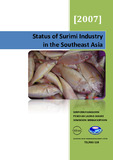| dc.description.abstract | Fish paste products have long been a part of traditional Asian cuisine, but surimi has become one of the most dynamic commodities in the Asian seafood industry because of recent innovations in production and utilization. Surimi is an intermediate product made from minced fish meat that has been washed, refined, and mixed with cyro-protectants. Although fish paste products have been hand-made for centuries, a process for frozen surimi, invented in 1960 provided the impetus for expanding the industry and surimi markets based on the vast walleye pollock, alaska pollock resources. The Asian surimi industry was under-going a period of rapid change as the Republic of Korea, Thailand, New Zealand, and the United States were increasingly challenging Japan's position as the world's leading surimi producer. The appreciation of the yen and the Japanese exclusion from U.S. and Soviet walleye or Alaska pollock resources, have caused Japanese production to decline from its 1984 peak of 418,000 MT to 320,000 MT in 1989 and decreased to only 132,000 in 1994. Meanwhile, the output of the other four major producing countries has increased from about 26,000 MT to 260,000 MT during the same period.
The Korean surimi industry shows the greatest potential for independent growth among the Asian surimi producers, with an output of 60,000 MT in 1989. During this period, Thai industries also has showed considerable growth potential dependent upon the Japanese technical assistance. The success of Thai surimi industry stimulated developments of surimi production in the Southeast Asian countries such as Malaysia, Myanmar, Vietnam, and Indonesia.
According to rapid growth of surimi industry in Southeast Asian countries, as well as depletion of fisheries resources especially demersal resources, reduction of raw materials may impact to the demand of surimi producers. Therefore under the Asian-SEAFDEC program SEAFDEC/TD proposed to conduct the information collection of economically important species as surimi raw materials in the Southeast Asian. The program was started from 2005 by collecting all information concerns in cooperation with the local fisheries agency and fishery private sectors. Field trip to observe and interview the surimi producers were also performed such as Thailand, Indonesia, Vietnam and Myanmar. Information from Malaysia mostly based on the questionnaires incooperation with DOF/Malaysia. In this study, the attempt is not only to show the quantity of surimi products in the region, but the linkage between surimi products and raw materials used in each country in comparison with the status of fisheries resources in the region will also analyzed. | en |

